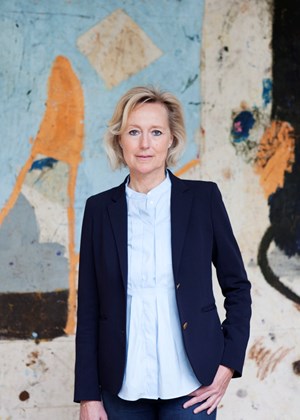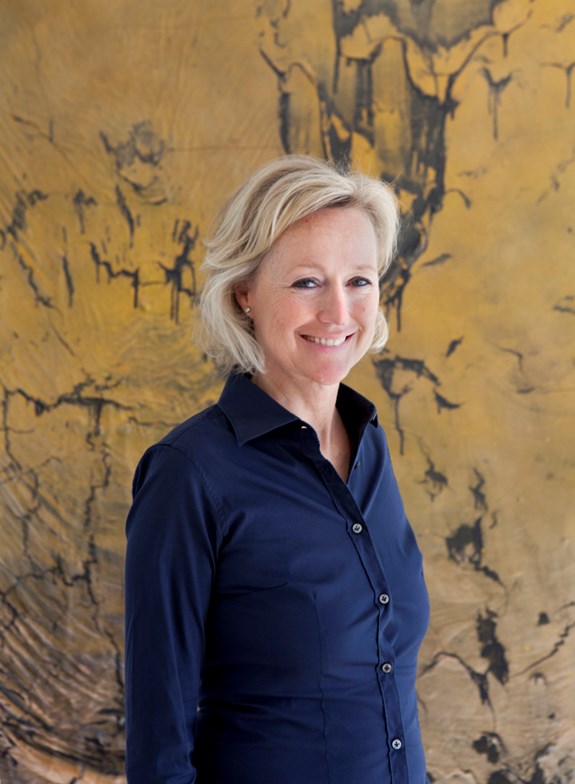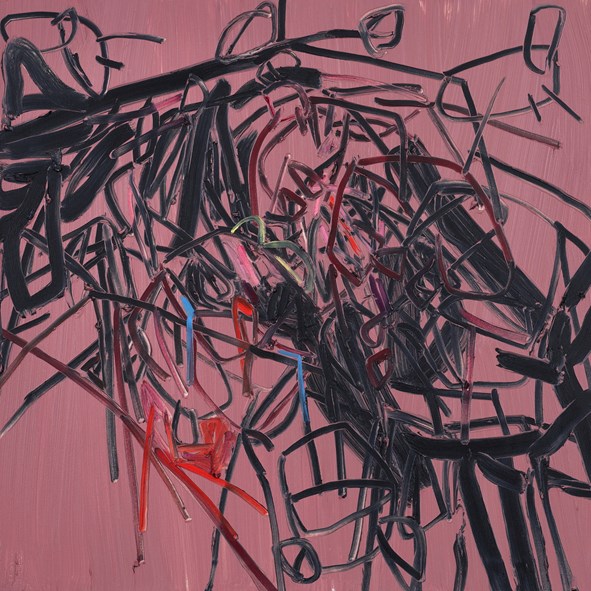
"Like any other market, the art market responds to supply and demand at a given time. When is an artist, an artist successful? If they are collected, exhibited, discussed and that is reflected in the price. However, this price should not be confused with the artistic value of a work. However, I am only interested in the market, whether I can afford a work or not".
Image: Carolin Scharpff-Striebich, photo courtesy for Carolin Scharpff-Striebich
ArtDependence (AD): You are a collector in the 2ndgeneration, is this right?
Carolin Scharpff-Striebich (CSS): Yes, my parents Ute and Rudolf Scharpff have been building the collection since the 1960s. At first, they were interested in the French Nouveaux Réalistes, then in the 1980s in the Graffiti and social-critical conceptual art from America. They have assembled entire blocks of work and spaces, for example by Robert Gober and Cady Noland.
Only in the 1990s did painting finally emerge as a focal point of the collection.
AD: What was collected then?
CSS: Contemporary painting: from America and Europe. My parents did not actually collect so many artists, but if they chose someone, they were loyal for decades.
AD: Growing up with art, do you have a childhood memory?
CSS: Whenever I am in the Staatsgalerie Stuttgart, I visit »cleaning lady«. This is one of the life-like sculptures of Duane Hanson, who once belonged to us. At the end of the 1970s she was sitting on the staircase with us and regularly caused uproar. For example, when a new postman came into the house, greeted in a friendly manner and the salutation was "inexplicably" not reciprocated. At some point, my parents gave her to the State Gallery, where she sat behind a big window and prattled. And again she was considered "real." The police were called several times at night because people thought that a cleaning lady had been accidentally locked in. To this day, she is a crowd pleaser and is pretty much missed, when she should not be there.

Carolin Scharpff-Striebich, photo courtesy for Carolin Scharpff-Striebich
But growing up with art, it is sometimes annoying, too. Especially, when you are in puberty. You are always responsible that nothing happens to the art works, even during a party… And I remember being a child my father swapped three paintings for one – I thought, he would make a big mistake. It took me a while to understand it.
AD: You are the Director of the collection now. When did you take over this position?
CSS: In 2004 I took over the management of the collection and considered what I really want to do with it. All walls were full and there was a huge warehouse. To even get an overview, I have first created an archive and divided the storage. All the works in one place, the risk was too high for me.
AD: Your collection is also an- Open Depot-what do you mean with this idea?
CSS: No artist wants to land hidden in some camp, but all want to be seen and experienced. Early on we had very good and close relationships with various museums, which have been facing enormous challenges for a long time: dwindling purchasing budgets, overcrowded warehouses and no budgets for external storage and increasingly expensive insurance. My parents and I decided, that we want to supportpublic museums. This is how the "Open Depot" model emerged: five selected museums can access our portfolio for exhibitions or to supplement their own collections.
AD: Which museums are taking part in that model and how does it work?
CSS: As we come from Stuttgart, these are of course the Staatsgalerie and the Kunstmuseum, then the Kunstmuseum Bonn, the Hamburger Kunsthalle and, most recently, the Kunsthalle Mannheim.
How the cooperation works can be well explained at the Kunstmuseum Bonn. Its collection focuses on German art after 1945. But they have no Neo Rauch, no André Butzer and only one work by Albert Oehlen. All artists who are represented in our collection. The museum can now look at what we have and select. Maybe they set up a temporary space, supplement a collection presentation or integrate it into a thematic exhibition. Whether a work is exhibited for only a day or several years, the museums can work with our collection according to their own ideas and wishes. But, there is a condition ... the works must be on display! As soon as this is not the case, they come back to us in the storage depot.

Neo Rauch, Plast 2001, Oil on paper, 200 x 254 cm, © VG Bild-Kunst, Bonn
AD: How is the procedure with the museums?
CSS: I visit them at least once a year and show what's new and what changed. Also, the works from my own collection. This is a good shaking route for me, because not everything can withstand a museum's assessment.
AD: Can you explain this further?
CSS:After all, you buy with your heart and a work echoes.
In the museum, however, it is viewed with an art historical perspective and sometimes rated completely differently.
But that's the way to learn. Still, I do not let myself be disturbed.

Albert Oehlen, OT(Baum11), Oil on dibond, 250 x 125 cm, © The artist
AD: What do you pay attention to when collecting, what is especially important to you?
CSS: We collect contemporary art. So, it's important that the collection stays contemporary.
If I take the original collection of my parents, then it was 90% white male artists. A lot has already happened today. The museums show more and more artists missing in their collections. For this purpose, the Western-influenced canon is broken up and slowly expanded to a more conscious global, diverse and multiperspective art history. If the collection does not have any part in it, the "open depot" no longer has any meaning in the long run.
AD: So the future of your collection will be different?
CSS: My own collection today depicts this present and at the same time keeps the parental part of the collection alive. At the moment I am increasingly looking at figurative painting. There's been a blank space here for the past 15 years. I'm working on that right now. And then the sculpture. We have always acquired individual sculptures, but never systematically. I want to change that. I made a list of sculptures I like and incidentally they were all made by female sculptors.
AD: Is there a difference between your parents’ collection and your collection?
CSS: The collection parts build on each other and influence each other. There are no boundaries, but flowing transitions.
AD: Did your parents and you always agreed on the same art?
CSS: I grew up with my parents art. That was my personal vision school. Therefore, I fully share the understanding of art of my parents. Until the end, my dad and I have been discussing pictures every day for the past 15 years. He has supported all my suggestions. That was the best thing for me, this giganticdialogue. Now I try to see with his and my eyes and to hear inwardly what he would say.
AD: Do you pursue a certain collection philosophy?
CSS: Absolutely! I fill in gaps, continue the story of my parent’s collection and go new ways myself. At the moment I see a lot of figurative paintings. I think that's wonderful because after Georg Baselitz, Neo Rauch, Glenn Brown and André Butzer, nothing has convinced me for a long time. For example, because of the many African and Afro-American artists who are finally being appreciated, figurative painting has gained new momentum. And suddenly you notice new pieces of the puzzle, which were missing in the collection so far.
AD: How do you discover new artists?
CSS: I collect in contexts. It's good to see relationships within a collection. As an example: Recently, at a fair, I noticed a young artist. Her work did not go out of my mind and I began to collect information’s about her. Shortly thereafter, her name fell in conversation with an artist and I saw more of her work in a group exhibition. My intuition was confirmed and I called the gallery.
AD: Is possessing an art piece a motivator for you?
CSS: Discovering artists and finding a fitting piece for my mind jigsaw are always more exciting for me than just possessing.
AD: When do you buy?
CSS: Most of the time, I buy things that are foreign to me, that do not let me go, that I find sometimes downright unpleasant. Often, I think after a purchase, to have made a huge mistake. Only gradually, I approach, through the ongoing dispute. I'm not a quick viewer. I look, think, look again, keep thinking ...
If I like something very directly, I will keep my hands off it. Too often these are those works that only reinforce what one already knows and after a short time “fall off the wall”.

Anna Uddenberg, Focus (Padded Purpose), 2019, acrylic resin, fiberglass, mesh fabric, leather, vinyl fabric, boxing helmet, over-knee boots, chromed metal, mountain bike helmet, puffer jacket, bar stool Venus, synthetic hair, 140 x 64 x 65 cm, © The artist, Photo: Gunter Lepkowski
AD: What else influences your decision?
CSS: I am always careful when a work is charged by its environment or staging. You never know how strong the picture itself is. A work must be able to work alone,completely free. Certain rooms have their own story and thus influence the effect of a painting or a sculpture.
AD: What is your relationship with galleries?
CSS: Galleries play a large and not to be underestimated role, are my confidants and informants. I prefer to go to a gallery on a quiet day so that I have two or three hours to look and talk. I like it when gallery owners get me into things, I did not know yet and when they look beyond the horizon of their own program. In this way, I continue to educate myself.
AD: Do you have any advice for beginners?
CSS: Open your eyes and watch as many exhibitions as time permits. This is the only way to sharpen your own perception. By hearsay you do not make good collections, but distract yourself and make the wrong decisions. I always try to rely on my eyes, my soul and my head. Then start to collect on a small level, because mistakes are unavoidable and if you have started small, they didn’t heart so much.

Jadé Fadojutimi, When 15 minutes feel like a week, Oil on canvas, 101,5 x 101,5 cm, © The artist
AD: What do you thing about the art market?
CSS: Like any other market, the art market responds to supply and demand at a given time. When is an artist successful? If they are collected, exhibited, discussed and that is reflected in the price.
However, this price should not be confused with the artistic value of a work. The only thing that interests me is whether I can afford a work or not.
AD: Is there a difference between Europe and the US?
CSS: In America, the value of a work of art is actually often determined by the price.
This is different in Europe, since the price trend fortunately is much slower here. You can always find areas that you can gather well. For example, works on paper, editions or artist books. I first had to learn that the increase in value can make you very unfree even if you suddenly have a particularly valuable picture on the wall. Then the worry begins that it could be damaged. I watch the market so that I know how much the insurance needs to be covered.
AD: Is there currently a generation change?
CSS: Of course, art reacts to the new digital technologies. And every new technique expands artistic expression. In painting, I notice that there are many figurative-surreal positions today. Like a countermovement to the abstract painting of the last years, which is difficult to carry on and throws the viewer back on itself: one often only recognizes what one brings with oneself. This is different with figurative painting. These are readable stories and it seems to me; it will be told again.
AD: What is your dream project?
CSS: Last year I fulfilled one of my dream projects. I published a book about abstract art. In dialogues with experts from the international art scene we approached non-objective paintings by looking, trying to find the right words for our observations and looking again. Another dream project would be a curated show with our collection in a museum out of Germany.
AD: Last question: What’s your favorite art work?
CSS: I don’t have an all time favorite. If you look at a painting for a long time, your visual experience changes and you also look at it from another perspective in your life. Thus, the meaning is shifting constantly. That’s the fascinating thing about art.

ArtDependence Magazine is an international magazine covering all spheres of contemporary art, as well as modern and classical art.
ArtDependence features the latest art news, highlighting interviews with today’s most influential artists, galleries, curators, collectors, fair directors and individuals at the axis of the arts.
The magazine also covers series of articles and reviews on critical art events, new publications and other foremost happenings in the art world.
If you would like to submit events or editorial content to ArtDependence Magazine, please feel free to reach the magazine via the contact page.